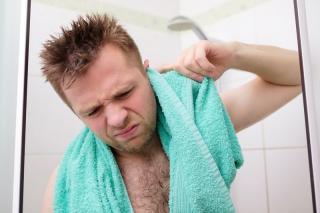Properly Removing Water from Your Ears

3 min read
Having water trapped in your ears is a common discomfort we’ve all experienced. It can lead to a condition known as swimmer’s ear, which is more than just an annoyance. Swimmer’s ear can present significant challenges, especially for those wearing hearing aids. Explore the causes and risks of swimmer’s ear, how it’s linked to hearing aids, and the proper ways to remove water from your ears.
Wearing hearing aids can increase the risk of swimmer’s ear and ear infections since hearing aids prevent natural drainage. This traps water in the ear canal, which then becomes a breeding ground for bacteria and fungi. For hearing aid users, vigilance against swimmer’s ear drying your ears thoroughly before inserting your hearing aids is particularly essential to maintain good ear health. Ensuring the ear canal is completely dry is crucial to prevent fungal and bacterial infections in the ear. Therefore, it is best to follow the steps to remove water from your ears after showering or swimming.
Consider these essential tips to prevent swimmer’s ear, particularly if you wear hearing aids:
What is Swimmer’s Ear?
Swimmer’s ear is an infection in the outer ear canal, often caused by trapped water, creating a damp environment that promotes bacterial growth. The name comes from the fact that swimmers often develop it, but exposure to any moist environment can cause it. Symptoms include itchiness, redness, and sometimes pain. The presence of earwax can aggravate the condition, creating a sticky situation that traps fluid in the ear.
Hearing Aids and Swimmer’s Ear: A Risky Combination
Wearing hearing aids can increase the risk of swimmer’s ear and ear infections since hearing aids prevent natural drainage. This traps water in the ear canal, which then becomes a breeding ground for bacteria and fungi. For hearing aid users, vigilance against swimmer’s ear drying your ears thoroughly before inserting your hearing aids is particularly essential to maintain good ear health. Ensuring the ear canal is completely dry is crucial to prevent fungal and bacterial infections in the ear. Therefore, it is best to follow the steps to remove water from your ears after showering or swimming.
How to Prevent Swimmer’s Ear
Consider these essential tips to prevent swimmer’s ear, particularly if you wear hearing aids:
- Keep your ears dry: After swimming or showering, tilt your head to allow water to escape, and dry your ears gently with a towel.
- Avoid over-cleaning: Inserting Q-tips, fingers, and other foreign objects into the ear canal can push earwax further in, leading to swimmer’s ear, so avoid this practice.
- Use earplugs while swimming: If you wear hearing aids, remove them before getting in the water and insert earplugs to prevent fluid from entering the ear canal.
- Care for your hearing aids: Regular cleaning and proper storage keep your hearing aids clean so they don’t contribute to bacterial growth in the ear.
- Avoid contaminated water: Don’t swim in lakes, oceans, or other potentially dirty water to minimize the risk of infection.
How to Properly Remove Water from the Ears
It’s essential to remove water from your ears with care. Using Q-tips can lead to further problems by pushing the water deeper. Instead, try these methods:- Tilt and hop: Tilt your head to the side and hop gently to allow gravity to do its work.
- Use a hair dryer: Set the dryer on the lowest setting, hold it at arm’s length, and direct the air into your ear.
- Apply a warm compress: This helps evaporate the trapped water. Simply wet a cloth with warm water, wring it out, and hold it against your ear for a few minutes.
- Consider over-the-counter solutions: Special ear drops can aid in drying the ear canal.
